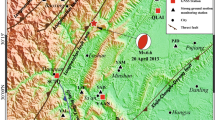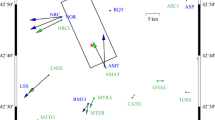Abstract
Very high-rate global positioning system (GPS) data has the capacity to quickly resolve seismically related ground displacements, thereby providing great potential for rapidly determining the magnitude and the nature of an earthquake’s rupture process and for providing timely warnings for earthquakes and tsunamis. The GPS variometric approach can measure ground displacements with comparable precision to relative positioning and precise point positioning (PPP) within a short period of time. The variometric approach is based on single-differencing over time of carrier phase observations using only the broadcast ephemeris and a single receiver to estimate velocities, which are then integrated to derive displacements. We evaluate the performance of the variometric approach to measure displacements using 50 Hz GPS data, which were recorded during the 2013 MW 6.6 Lushan earthquake and the 2011 MW 9.0 Tohoku-Oki earthquake. The comparison between 50 and 1 Hz seismic displacements demonstrates that 1 Hz solutions often fail to faithfully manifest the seismic waves containing high-frequency seismic signals due to aliasing, which is common for near-field stations of a moderate-magnitude earthquake. Results indicate that 10–50 Hz sampling GPS sites deployed close to the source or the ruptured fault are needed for measuring dynamic seismic displacements of moderate-magnitude events. Comparisons with post-processed PPP results reveal that the variometric approach can determine seismic displacements with accuracies of 0.3–4.1, 0.5–2.3 and 0.8–6.8 cm in the east, north and up components, respectively. Moreover, the power spectral density analysis demonstrates that high-frequency noises of seismic displacements, derived using the variometric approach, are smaller than those of PPP-derived displacements in these three components.








Similar content being viewed by others
References
Allen RM, Ziv A (2011) Application of real-time GPS to earthquake early warning. Geophys Res Lett 38:L16310
Avallone A et al (2011) Very high rate (10 Hz) GPS seismology for moderate-magnitude earthquakes: The case of the M w 6.3 L’Aquila (central Italy) event. J Geophys Res 116:B02305
Benedetti E, Branzanti M, Biagi L, Colosimo G, Mazzoni A, Crespi M (2014) Global navigation satellite systems seismology for the 2012 M w 6.1 Emilia earthquake: exploiting the VADASE algorithm. Seismol Res Lett 85(3):649–656
Bilich A, Cassidy JF, Larson KM (2008) GPS seismology: application to the 2002 M w 7.9 Denali fault earthquake. B Seismol Soc Am 98(2):593–606
Bock Y, Prawirodirdjo L, Melbourne TI (2004) Detection of arbitrarily large dynamic ground motions with a dense high-rate GPS network. Geophys Res Lett 31(6):L06604
Bock Y, Melgar D, Crowell BW (2011) Real-time strong-motion broadband displacements from collocated GPS and accelerometers. Bull Seismol Soc Am 101(6):2904–2925
Branzanti M, Colosimo G, Crespi M, Mazzoni A (2013) GPS near-real-time coseismic displacements for the great Tohoku-oki earthquake. IEEE Geosci Remote Sens Lett 10(2):372–376
Celebi M, Sanli A (2002) GPS in pioneering dynamic monitoring of long-period structures. Earthquake Spectra 18(1):47–61
Colombelli S, Allen RM, Zollo A (2013) Application of real-time GPS to earthquake early warning in subduction and strike-slip environments. J Geophys Res 118(7):3448–3461
Colosimo G, Crespi M, Mazzoni A (2011) Real-time GPS seismology with a stand-alone receiver: a preliminary feasibility demonstration. J Geophys Res 116:B11302
Crowell BW, Bock Y, Squibb MB (2009) Demonstration of earthquake early warning using total displacement waveforms from real-time GPS networks. Seismol Res Lett 80(5):772–782
Fang R, Shi C, Song W, Wang G, Liu J (2014) Determination of earthquake magnitude using GPS displacement waveforms from real-time precise point positioning. Geophys J Int 196(1):461–472
Fratarcangeli F, Savastano G, D’Achille M, Mazzoni A, Crespi M, Riguzzi F, Devoti R, Pietrantonio G (2018) VADASE reliability and accuracy of real-time displacement estimation: application to the Central Italy 2016 earthquakes. Remote Sens 10(8):1201
Galetzka J et al (2015) Slip pulse and resonance of the Kathmandu basin during the 2015 Gorkha earthquake, Nepal. Science 349(6252):1091–1095
Geng T, Xie X, Fang R, Su X, Zhao Q, Liu G, Li H, Shi C, Liu J (2016) Real-time capture of seismic waves using high-rate multi-GNSS observations: Application to the 2015 M w 7.8 Nepal earthquake. Geophys Res Lett 43(1):161–167
Genrich JF, Bock Y (2006) Instantaneous geodetic positioning with 10–50 Hz GPS measurements: noise characteristics and implications for monitoring networks. J Geophys Res 111(B3):B03403
Grapenthin R, Freymueller JT (2011) The dynamics of a seismic wave field: animation and analysis of kinematic GPS data recorded during the 2011 Tohoku-oki earthquake, Japan. Geophys Res Lett 38:L18308
Heroux P, Kouba J (2001) GPS precise point positioning using IGS orbit products. Phys Chem Earth 26(6–8):573–578
Hung H-K, Rau R-J, Benedetti E, Branzanti M, Mazzoni A, Colosimo G, Crespi M (2017) GPS Seismology for a moderate magnitude earthquake: Lessons learned from the analysis of the 31 October 2013 ML 6.4 Ruisui (Taiwan) earthquake. Ann Geophys 60(5):S0553
Kouba J (2003) Measuring seismic waves induced by large earthquakes with GPS. Stud Geophys Geod 47(4):741–755
Larson KM (2009) GPS seismology. J Geod 83(3–4):227–233
Larson KM, Bodin P, Gomberg J (2003) Using 1 Hz GPS data to measure deformations caused by the Denali fault earthquake. Science 300(5624):1421–1424
Li X, Guo B, Lu C, Ge M, Wickert J, Schuh H (2014) Real-time GNSS seismology using a single receiver. Geophys J Int 198(1):72–89
Melgar D, Crowell BW, Geng J, Allen RM, Bock Y, Riquelme S, Hill EM, Protti M, Ganas A (2015) Earthquake magnitude calculation without saturation from the scaling of peak ground displacement. Geophys Res Lett 42(13):5197–5205
Miyazaki S, Larson KM, Choi K, Hikima K, Koketsu K, Bodin P, Haase J, Emore G, Yamagiwa A (2004) Modeling the rupture process of the 2003 September 25 Tokachi-Oki (Hokkaido) earthquake using 1 Hz GPS data. Geophys Res Lett 31:L21603
Moschas F, Stiros S (2015) Dynamic deflections of a stiff footbridge using 100 Hz GNSS and accelerometer data. J Surv Eng 141(4):04015003
Niu X, Chen Q, Zhang Q, Zhang H, Niu J, Chen K, Shi C, Liu J (2013) Using Allan variance to analyze the error characteristics of GNSS positioning. GPS Solut 18(2):231–242
Nyquist H (1928) Certain topics in telegraph transmission theory. Trans Am Inst Electr Eng 47(2):617–644
Ogaja C, Li X, Rizos C (2007) Advances in structural monitoring with global positioning system technology: 1997–2006. J Appl Geodesy 1(3):171–179
Ohta Y et al (2012) Quasi real-time fault model estimation for near-field tsunami forecasting based on RTK-GPS analysis: application to the 2011 Tohoku-Oki earthquake (M w 9.0). J Geophys Res 117:B02311
Shi C, Zhao Q, Geng J, Lou Y, Ge M, Liu J (2008) Recent development of PANDA software in GNSS data processing. In: Proceedings of international conference on Earth observation data processing and analysis (ICEODPA). Wuhan, China, 28–30 December, p 72851S
Smalley R (2009) High-rate GPS: how high do we need to go? Seismol Res Lett 80(6):1054–1061
Wright TJ, Houlie N, Hildyard M, Iwabuchi T (2012) Real-time, reliable magnitudes for large earthquakes from 1 Hz GPS precise point positioning: the 2011 Tohoku-Oki (Japan) earthquake. Geophys Res Lett 39:L12302
Xu P, Shi C, Fang R, Liu J, Niu X, Zhang Q, Yanagidani T (2013) High-rate precise point positioning (PPP) to measure seismic wave motions: An experimental comparison of GPS PPP with inertial measurement units. J Geod 87(4):361–372
Yin H, Wdowinski S (2013) Improved detection of earthquake-induced ground motion with spatial filter: case study of the 2012 M = 7.6 Costa Rica earthquake. GPS Solut 18(4):563–570
Zumberge J, Heflin M, Jefferson D, Watkins M, Webb F (1997) Precise point positioning for the efficient and robust analysis of GPS data from large networks. J Geophys Res 102(B3):5005–5017
Acknowledgements
This work is supported by the National Natural Science Foundation of China (Nos. 41631073, 41874038, 41231174 and 41325015). We thank two anonymous reviewers and the Editor Alfred Leick, for their detailed and constructive comments which significantly improved the manuscript.
Author information
Authors and Affiliations
Corresponding author
Electronic supplementary material
Below is the link to the electronic supplementary material.
Rights and permissions
About this article
Cite this article
Shu, Y., Fang, R., Li, M. et al. Very high-rate GPS for measuring dynamic seismic displacements without aliasing: performance evaluation of the variometric approach. GPS Solut 22, 121 (2018). https://doi.org/10.1007/s10291-018-0785-z
Received:
Accepted:
Published:
DOI: https://doi.org/10.1007/s10291-018-0785-z




